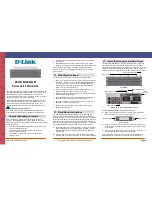
Chapter 19: RMON
268
Alarms
RMON alarms are used to generate alert messages when packet activity
on designated ports rises above or falls below specified threshold values.
The alert messages can take the form of messages that are entered in the
event log on the switch, traps that are sent to your SNMP NMS software,
or both.
RMON alarms consist of two thresholds: a rising threshold and a falling
threshold. The alarm is triggered if the value of the monitored RMON
statistic of the designated port exceeds the rising threshold. The response
of the switch is to enter a message in the event log, send an SNMP trap,
or both. The alarm is reset if the value of the monitored statistic drops
below the falling threshold.
The frequency with which the switch samples the thresholds of an alarm
against the actual RMON statistic is controlled by a time interval
parameter. You can adjust this interval for each alarm.
Here are the three components that comprise RMON alarms:
RMON statistics group: A port must have an RMON
statistics group configured if it is to have an alarm.
When you create an alarm, you specify the port to
which it is to be assigned, not by the port number, but
rather by the ID number of the port’s statistics group.
(As explained in “Port Statistics” on page 262,
statistics groups are also used to remotely view port
statistics in the RMON portion of the MIB tree.)
RMON event: An event specifies the action of the
switch when the ingress packet activity on a port
crosses a statistical threshold defined in an alarm. The
choices are to log a message in the event log of the
switch, send an SNMP trap to an SNMP workstation,
or both. Since there are only three possible actions,
and since events can be used with more than one
alarm, you probably will not create more than three
events.
Alarm: The last component is the alarm itself. It defines
the port statistic to be monitored and the rising and
falling thresholds that trigger the switch to perform an
event. The thresholds of an alarm can have the same
event or different events. The switch supports up to
eight alarms.
Содержание AT-GS950/48
Страница 10: ...Contents 10...
Страница 14: ...Figures 14...
Страница 16: ...List of Tables 16...
Страница 20: ...Preface 20...
Страница 22: ...22...
Страница 62: ...Chapter 2 System Configuration 62...
Страница 64: ...64...
Страница 108: ...Chapter 6 Static Port Trunking 108...
Страница 124: ...Chapter 8 Port Mirroring 124...
Страница 186: ...Chapter 13 Virtual LANs 186...
Страница 194: ...Chapter 14 GVRP 194...
Страница 210: ...210...
Страница 224: ...Chapter 16 SNMPv1 and v2c 224...
Страница 242: ...Chapter 17 SNMPv3 242...
Страница 258: ...Chapter 18 Access Control Configuration 258...
Страница 272: ...Chapter 19 RMON 272...
Страница 302: ...Chapter 21 Security 302...
Страница 324: ...Chapter 23 LLDP 324...
Страница 338: ...338...
Страница 356: ...Chapter 27 LED ECO Mode 356...
Страница 360: ...Chapter 28 Energy Efficient Ethernet 360...
Страница 370: ...Chapter 29 Rebooting the AT GS950 48 370...
Страница 392: ...Appendix A MSTP Overview 392...
















































